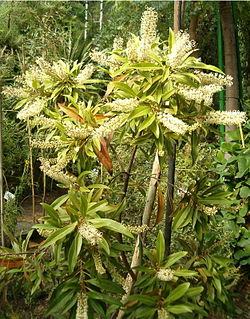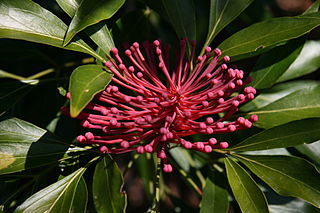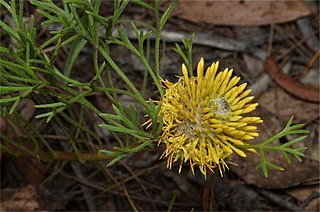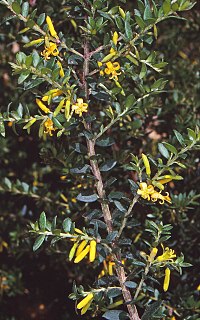
Wollemia is a genus of coniferous tree in the family Araucariaceae. Wollemia was known only through fossil records until the Australian species Wollemia nobilis was discovered in 1994 in a temperate rainforest wilderness area of the Wollemi National Park in New South Wales, in a remote series of narrow, steep-sided sandstone gorges 150 km (93 mi) northwest of Sydney. The genus is named after the National Park.

Telopea speciosissima, commonly known as the New South Wales waratah or simply waratah, is a large shrub in the plant family Proteaceae. It is endemic to New South Wales in Australia and is the floral emblem of that state. No subspecies are recognised, but the closely related Telopea aspera was only recently classified as a separate species.

Viola banksii, commonly known as native violet, is sold and grown throughout garden nurseries and grown and loved in gardens around Australia, especially in the east. For many years it was known as Viola hederacea, however the species complex was revised in 2004 by Kevin Thiele, with the name, Viola banksii, being published in 2003 by Kevin Thiele and Suzanne Prober. Although the Native Violet was initially collected by Banks and Solander, the type specimen was either lost or not provided until a collection by Jacques Labillardière in Tasmania. Thiele discovered that the original type specimen of V. hederacea collected by Labillardière was not the same as the hardier and showier plant later collected, cultivated and widely sold. This second form, native to the east coast from near Brisbane to Batemans Bay, he named Viola banksii. This species is distinguished by its striking purple and white flowers. As well, the fully developed leaves are almost circular in outline with a deep, narrow, v-shaped sinus at the base, and are usually rather bright, fresh green.

Viola hederacea, the Australian violet, is a species of flowering plant in the family Violaceae, native to Australia.

Buckinghamia is a genus of only two known species of trees, belonging to the plant family Proteaceae. They are endemic to the rainforests of the wet tropics region of north eastern Queensland, Australia. The ivory curl flower, B. celsissima, is the well known, popular and widely cultivated species in gardens and parks, in eastern and southern mainland Australia, and additionally as street trees north from about Brisbane. The second species, B. ferruginiflora, was only recently described in 1988.
Kevin R. Thiele is currently an adjunct associate professor at the University of Western Australia and the director of Taxonomy Australia. He was the curator of the Western Australian Herbarium from 2006 to 2015. His research interests include the systematics of the plant families Proteaceae, Rhamnaceae and Violaceae, and the conservation ecology of grassy woodland ecosystems. He also works in biodiversity informatics, developing and teaching the development of interactive multi-access keys, and has been involved in the design of software for the Global Biodiversity Information Facility.
Alloxylon brachycarpum is a species of plant in the family Proteaceae. It is found in Indonesia and Papua New Guinea. It is threatened by habitat loss.

Telopea mongaensis, commonly known as the Monga waratah or Braidwood waratah, is a shrub or small tree in the family Proteaceae. Endemic to Australia, it grows at high altitude in south eastern New South Wales, where it is often seen in moist areas at the edge of rainforest or by streams in eucalyptus forests. Growing to 6 m (20 ft) high, it has narrow green leaves 4–18 cm (1.6–7.1 in) in length, and 0.5–2 cm (0.20–0.79 in) wide. In spring bears many red flowerheads, each made up of 28 to 65 individual flowers.

Telopea oreades, commonly known as the Gippsland-, mountain- or Victorian waratah, is a large shrub or small tree in the family Proteaceae. Native to southeastern Australia, it is found in wet sclerophyll forest and rainforest on rich acidic soils high in organic matter. No subspecies are recognised, though a northern isolated population hybridises extensively with the Braidwood waratah (T. mongaensis). Reaching a height of up to 19 metres, T. oreades grows with a single trunk and erect habit. It has dark green leaves with prominent veins that are 11–28 centimetres (4.3–11 in) long and 1.5–6 cm (0.6–2.4 in) wide. The red flower heads, known as inflorescences, appear in late spring. Each is composed of up to 60 individual flowers.

Telopea aspera, commonly known as the Gibraltar Range waratah, is a plant in the family Proteaceae. It grows as a woody shrub to 3 metres (10 ft) high with leathery rough leaves and bright red flower heads known as inflorescences—each composed of hundreds of individual flowers. It is endemic to the New England region in New South Wales in Australia. It was formally described as a species by botanists Peter Weston and Mike Crisp in 1995, separated from its close relative Telopea speciosissima by its rough foliage and preference for dryer habitat. Unlike its better known relative, Telopea aspera has rarely been cultivated.

Alloxylon pinnatum, known as Dorrigo waratah, is a tree of the family Proteaceae found in warm-temperate rainforest of south-east Queensland and northern New South Wales in eastern Australia. It has shiny green leaves that are either pinnate (lobed) and up to 30 cm (12 in) long, or lanceolate (spear-shaped) and up to 15 cm (5.9 in) long. The prominent pinkish-red flower heads, known as inflorescences, appear in spring and summer; these are made up of 50 to 140 individual flowers arranged in corymb or raceme. These are followed by rectangular woody seed pods, which bear two rows of winged seeds.

Isopogon prostratus, commonly known as prostrate cone-bush, is a species of plant in the family Proteaceae and is endemic to south-eastern Australia. It is a prostrate shrub with divided leaves with linear lobes, and more or less spherical heads of yellow flowers on the ends of branchlets.

Persoonia mollis, commonly known as soft geebung, is a plant in the family Proteaceae and is endemic to New South Wales. It is an erect to prostrate shrub with linear to oblong or spatula-shaped leaves, yellow flowers in groups of up to thirty on a rachis up to 150 mm (5.9 in) long and relatively small fruit.
Budawangia is a monotypic genus of flowering plants in the family Ericaceae. The sole species is Budawangia gnidioides from New South Wales. The genus was formally described in 1992.

Persoonia asperula, commonly known as mountain geebung, is a plant in the family Proteaceae and is endemic to south-eastern Australia. It is an erect or prostrate shrub with smooth bark, mostly elliptic to oblong leaves and yellow flowers borne singly or in groups of up to nine. It mostly occurs in the Southern Highlands of New South Wales. A small population in Victoria may be a different species.

The National Herbarium of New South Wales was established in 1853. The Herbarium has a collection of more than 1.4 million plant specimens, making it the second largest collection of pressed, dried plant specimens in Australia, including scientific and historically significant collections and samples of Australian flora gathered by Joseph Banks and Daniel Solander during the voyage of HMS Endeavour in 1770.

Persoonia brevifolia is a plant in the family Proteaceae and is endemic to a restricted area near the border between south-eastern New South Wales and Victoria. It is an erect shrub with elliptic to egg-shaped leaves and cylindrical yellow flowers arranged singly in leaf axils.
Barbara Lynette Rye is an Australian botanist born in 1952.

Anthony Norman Rodd, known as Tony Rodd, is an Australian botanist.
Donald Frederick Blaxell, is an Australian botanist, botanical collector and taxonomist.














